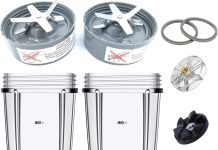Are you a tomato enthusiast who loves to experiment in the kitchen? If you’re wondering whether it’s possible to juice tomatoes with seeds using a masticating juicer, you’ve come to the right place! In this article, we will explore whether masticating juicers can handle tomato seeds and the potential benefits of including them in your juice. Get ready to discover a new way to enjoy the goodness of tomatoes in all their juicy glory!
Review contents
Background on masticating juicers
Masticating juicers, also known as slow juicers or cold press juicers, are a type of juicer that use a slow and gentle extraction process to produce juice. Unlike centrifugal juicers, which rely on high-speed spinning blades to extract juice, masticating juicers use a rotating auger to crush and chew the fruits and vegetables, effectively breaking down the cell walls and releasing more nutrients and enzymes.
How masticating juicers work
Masticating juicers work by first feeding the produce into a chute, which leads to a rotating auger. As the auger spins, it slowly crushes and grinds the produce, extracting the juice. The juice is then filtered through a fine mesh sieve, separating it from the pulp. The pulp is typically ejected into a separate container, while the juice is collected in a juice container.
Benefits of using a masticating juicer
There are several benefits to using a masticating juicer. Firstly, the slow and gentle extraction process of a masticating juicer helps retain more nutrients and enzymes in the juice. This means that you can enjoy a more nutritious and flavorful juice with all the health benefits intact. Additionally, masticating juicers are versatile and can handle a wide range of fruits and vegetables, including leafy greens and even wheatgrass. They are also quieter than centrifugal juicers and tend to produce less foam and oxidation, resulting in a juice with a longer shelf life.
Drawbacks of using a masticating juicer
While masticating juicers offer many advantages, there are also a few drawbacks to consider. Firstly, masticating juicers tend to have a slower juicing process due to their slow rotation speed. This means that it may take longer to extract juice compared to a centrifugal juicer. Additionally, masticating juicers often have a smaller feeding chute, requiring you to cut your produce into smaller pieces before juicing. Lastly, masticating juicers can be more expensive than centrifugal juicers, making them a pricier option for those on a budget.
Tomatoes and their seeds
Overview of tomatoes
Tomatoes are a popular fruit that is widely consumed around the world. They come in various sizes and colors, including red, orange, yellow, and even purple. Tomatoes are rich in essential nutrients such as vitamin C, vitamin A, potassium, and lycopene, a powerful antioxidant that has been linked to various health benefits.
Nutritional value of tomato seeds
Tomato seeds, contrary to popular belief, are actually quite nutritious. They contain a good amount of dietary fiber, healthy fats, and antioxidants. Additionally, tomato seeds are a good source of minerals such as calcium, iron, and magnesium. Including tomato seeds in your diet can contribute to your overall nutrient intake and enhance the nutritional value of your meals.
Health benefits of consuming tomato seeds
Consuming tomato seeds can offer several health benefits. The dietary fiber found in tomato seeds can aid in digestion and promote bowel regularity. The healthy fats in tomato seeds, such as omega-3 fatty acids, can support heart health and reduce inflammation in the body. The antioxidants present in tomato seeds help protect against free radical damage and may have anticancer properties. Adding tomato seeds to your diet can be a simple and beneficial way to boost your overall health and well-being.
Juicing tomatoes with seeds in a masticating juicer
Can masticating juicers handle tomato seeds?
Yes, masticating juicers are generally capable of handling tomato seeds. The slow and gentle extraction process of a masticating juicer allows it to effectively separate the juice from the seeds, resulting in a smooth and pulp-free tomato juice.
Effect of tomato seeds on juicing process
The presence of tomato seeds in the juicing process may slightly affect the texture and consistency of the juice. The seeds can add a bit of thickness to the juice, creating a more pulpy texture. However, the overall effect is minimal, and the juicer should be able to extract the majority of the juice from the tomatoes while leaving behind the seeds.
Tips for juicing tomatoes with seeds in a masticating juicer
To ensure the best results when juicing tomatoes with seeds in a masticating juicer, here are a few tips to keep in mind:
- Choose ripe and juicy tomatoes: Ripe tomatoes will yield more juice and make the juicing process easier.
- Cut the tomatoes into smaller pieces: This will help the juicer handle the tomatoes more efficiently, ensuring optimal extraction of juice.
- Alternate tomato pieces with other produce: To minimize the impact of the seeds on the overall texture, try alternating tomato pieces with other fruits or vegetables during the juicing process.
- Clean the juicer thoroughly: After juicing tomato seeds, make sure to clean the juicer thoroughly to prevent any residue from affecting the performance of the juicer in future juicing sessions.
Implications for juice quality and taste
Texture and consistency of tomato juice with seeds
When juicing tomatoes with seeds in a masticating juicer, the resulting juice may have a slightly thicker and more pulpy texture compared to juice without seeds. The presence of seeds can add a subtle graininess to the juice, but it should still be relatively smooth overall. If you prefer a smoother consistency, you can strain the juice after extraction to remove any remaining seeds or pulp.
Flavor profile of tomato juice with seeds
Tomato juice with seeds retains the natural flavors of the tomatoes, with a slightly earthy and sweet taste. The seeds themselves have a mild, nutty flavor that can enhance the overall taste of the juice. If you enjoy the taste of tomatoes and appreciate a bit of texture in your juice, juicing tomatoes with seeds can be a flavorful and enjoyable option.
Impact on nutrient content in tomato juice with seeds
Juicing tomatoes with seeds in a masticating juicer should not significantly impact the nutrient content of the juice. The slow and gentle extraction process of the juicer helps preserve the nutrients and enzymes in the tomatoes, ensuring that you still reap the health benefits. However, it’s important to note that some nutrients, such as dietary fiber, may be slightly reduced if you choose to strain the juice to remove the seeds.
Alternatives to consider
Straining tomato juice after extraction
If you prefer a seedless tomato juice with a smoother consistency, you can strain the juice after extraction. Simply pour the juice through a fine mesh sieve or cheesecloth to remove any seeds or pulp. This method will result in a seed-free juice with a lighter texture.
Using a different type of juicer for tomato seeds
If the presence of seeds in your tomato juice is a concern, you may consider using a different type of juicer that specializes in seed removal, such as a centrifugal juicer. These juicers typically have built-in strainers that effectively separate the seeds from the juice during the extraction process.
Blending tomato seeds instead of juicing
Alternatively, if you still want to include the nutritional benefits of tomato seeds in your diet but prefer to avoid their presence in your juice, you can blend the seeds instead of juicing them. Simply blend ripe tomatoes with the seeds intact to create a smooth tomato puree or sauce that can be used in various recipes.
Conclusion
In conclusion, masticating juicers are capable of handling tomato seeds and can produce delicious and nutritious tomato juice. While the presence of seeds may affect the texture and consistency of the juice, the overall impact is minimal. Juicing tomatoes with seeds in a masticating juicer allows you to enjoy the health benefits of tomato seeds while still enjoying the natural flavors of the tomatoes. However, if you prefer a seedless and smoother juice, you can strain the juice after extraction or explore alternative juicing methods. Ultimately, the decision to include or exclude tomato seeds in your juice comes down to personal preference and desired texture.
































